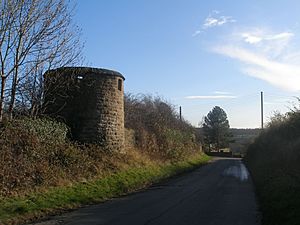Houndhill facts for kids
Houndhill is a very old and important farmhouse located in Worsbrough, near Barnsley, South Yorkshire, England. It's a special building from the Tudor period, built partly with wood frames and partly with stone.
This house was mostly built in the late 1500s, with some parts added in the 1600s. Robert Elmhirst was the first person to build it. His son, Richard Elmhirst, was on the side of the King during the English Civil War. In 1642, Richard added strong defenses to the house to protect it. Houndhill was later fixed up and made new again in 1934.
The house is made of cut stone and has a roof of stone tiles. It has two floors and is shaped like the letter 'H'. The oldest part of the house is built with a timber (wood) frame.
A Look Back in Time: Houndhill's History
We first find records of the land at Houndhill in 1556. But we don't know exactly when the first house was built there. The Elmhirst family has lived in this area for a very long time. Old records from 1340 show Roger Elmhirst, an early family member, had to pay a small fine. This was because his horses wandered into the Lord of the Manor's field.
Later, in 1618, Richard Elmhirst said that Houndhill had been owned by his family for many generations. It had been passed down through twelve family lines!
Richard Elmhirst took over Houndhill in 1626. Around this time, he worked for a powerful man named Sir Thomas Wentworth. Richard was loyal to King Charles I. Because of this, he made Houndhill stronger, probably in 1642. He built two towers and started a wall around the house to protect it during the English Civil War.
People say that Houndhill was taken quite easily by Sir Thomas Fairfax in the summer of 1643. When Sir Thomas came to ask for the house to be given up, Richard Elmhirst agreed right away. Some soldiers wanted to hurt Richard, but Sir Thomas stopped them because he liked him.
In 1645, Richard had to tell the government how much money and land he owned. After a long check, he was told to pay a large fine of £666. He finally paid it in 1650. Richard passed away in 1654, leaving behind his wife and nine children.
When Richard's son, also named Richard Elmhirst, died in 1673, some of his land went to his brother William. But Houndhill and most of his other wealth went to his daughter, Elizabeth. She married John Copley, and Houndhill later became owned by Capt F.W.T.V. Wentworth.
In 1932, Alfred O. Elmhirst helped his brother, Leonard Knight Elmhirst, buy Houndhill back. Leonard was a well-known person who gave a lot to good causes. After they bought it, Houndhill was greatly repaired and made new. In 1950, Leonard gave Houndhill to A.O. Elmhirst, who lived there from 1932 until he passed away in 1995. Their other brother was Air Marshal Sir Thomas Elmhirst, who was a very important leader in the Royal Indian Air Force. He was also the Lieutenant-Governor of Guernsey.
For most of the 1900s, Houndhill and its nearby farmland had problems because of coal mining underground. However, the family also received money from the mining in the 1800s and early 1900s. In 1972, the area around Houndhill changed when the M1 motorway was built through the valley below it. The house and the land around it are still owned by the Elmhirst family. They have owned land in Worsbrough for more than 20 generations!
The Elmhirst Family Tree
You can find details about the Elmhirst family in a special book called Burke’s Landed Gentry. However, the family tree in that book isn't complete. For example, it doesn't show Richard Elmhirst (1738–1805). He was the third son of Thomas Elmhirst (1692–1769).
Richard's son, Philip (1781–1866), was a Midshipman (a young officer in training) on a ship called HMS Africa (1781). He fought in the famous Battle of Trafalgar. Because of his service, he was given 2000 acres of land near Peterborough, Ontario, in Canada. His brother Joseph joined him there and had eight children. Some of that land is still owned by Elmhirsts today, and there are many Elmhirsts living in Canada.
As far as we know, all living Elmhirst family members are related to Thomas Elmhirst (1649–1696). He was an important businessman in Boston, Lincolnshire, England.


